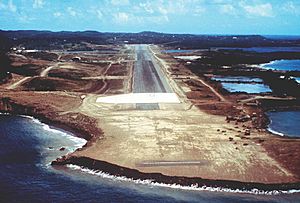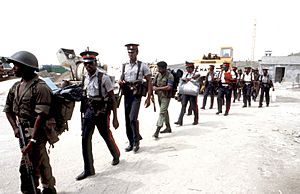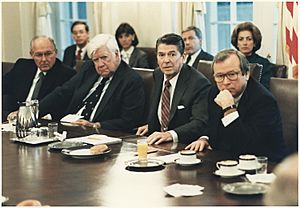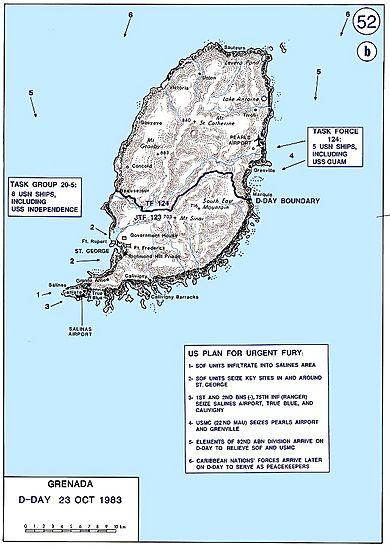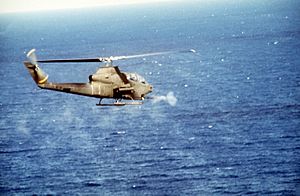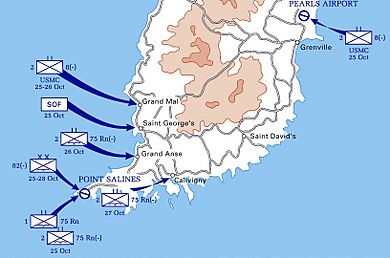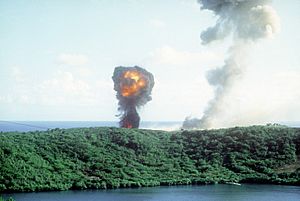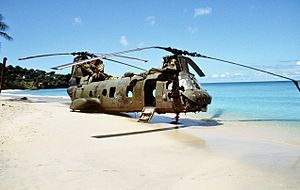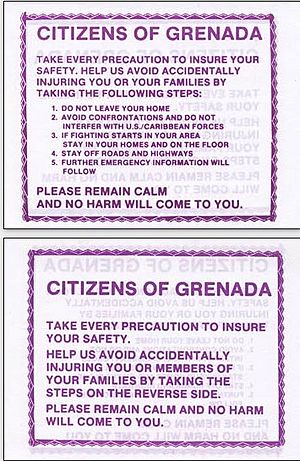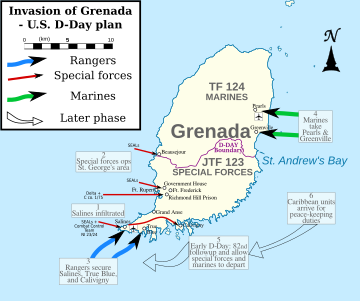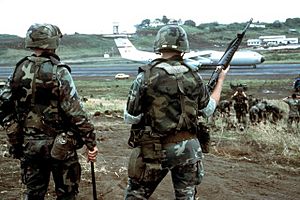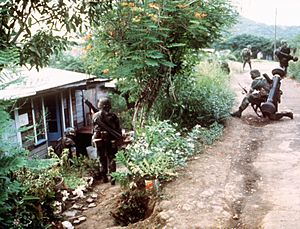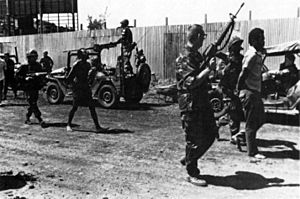United States invasion of Grenada facts for kids
Quick facts for kids United States invasion of Grenada |
|||||||
|---|---|---|---|---|---|---|---|
| Part of the Cold War | |||||||
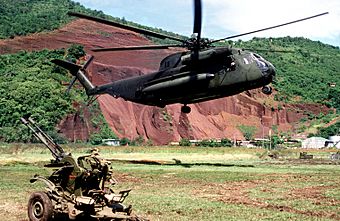 An American Sikorsky CH-53 Sea Stallion helicopter hovers above the ground near an abandoned Soviet ZU-23-2 anti-aircraft weapon during the American invasion of Grenada, 1983. |
|||||||
|
|||||||
| Belligerents | |||||||
Caribbean Peace Force:
|
Military advisors: |
||||||
| Commanders and leaders | |||||||
|
|||||||
| Strength | |||||||
CPF:
|
|
||||||
| Casualties and losses | |||||||
|
|
||||||
| 24 civilians killed (18 of them when a mental hospital was mistakenly bombed by U.S. Navy A-7s) | |||||||
The United States invasion of Grenada was a military operation that started on October 25, 1983. The United States and a group of six Caribbean nations, called the Caribbean Peace Force, invaded the island nation of Grenada. Grenada is about 100 miles (160 km) north of Venezuela. The U.S. military called this operation Operation Urgent Fury. The invasion quickly led to the military taking control of the island.
The invasion happened because of problems within Grenada's government, known as the People's Revolutionary Government. The leader, Maurice Bishop, was put under house arrest and then killed. A new military government, led by Hudson Austin, took over. The invasion removed this military government. After the invasion, a temporary government was set up, and new elections were held in 1984.
Grenada became independent from the United Kingdom in 1974. In 1979, a communist group called the New Jewel Movement, led by Maurice Bishop, took power in a coup (a sudden, illegal takeover of government). They stopped the country's constitution and held many political prisoners. In September 1983, a power struggle began over Bishop's leadership. Bishop was pressured to share power with his deputy, Bernard Coard. He first agreed but later changed his mind. His own party then put him under house arrest. When people found out, his supporters freed him. A fight then broke out between soldiers loyal to Coard and civilians supporting Bishop. On October 19, 1983, at least 19 people, including Bishop, were killed. The army, led by Hudson Austin, then formed a military council and put the Governor-General, Paul Scoon, under house arrest. They announced a strict curfew where anyone on the streets would be killed.
The U.S. government, led by President Ronald Reagan, decided to act after the Organisation of Eastern Caribbean States (OECS) asked for help. Governor-General Paul Scoon also secretly asked for military assistance. President Reagan said he had to act because of "concerns over the 600 U.S. medical students on the island." He worried about a repeat of the Iran hostage crisis, which had ended less than three years earlier. The invasion happened just two days after a bombing at a U.S. Marine base in Beirut.
The invading force included about 7,600 U.S. troops, along with forces from Jamaica and the Regional Security System (RSS). They quickly defeated the Grenadian forces. The invasion led to a temporary advisory council taking over, with Scoon as Governor-General, until elections in 1984.
Many countries criticized the invasion. British Prime Minister Margaret Thatcher did not approve of it privately because she was not told about it in advance. However, she supported it publicly. On November 2, 1983, the United Nations General Assembly said the invasion was "a flagrant violation of international law." They voted 108 to 9 against it.
Today, the date of the invasion is a national holiday in Grenada called Thanksgiving Day. It celebrates the freeing of political prisoners. In 2000, a truth and reconciliation commission was started to look into the events of that time. The invasion also showed problems with how different parts of the American military worked together. This led to big changes, like the Goldwater-Nichols Act, to improve how they operate.
Contents
Why the Invasion Happened
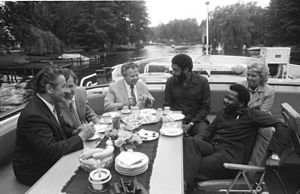
Sir Eric Gairy led Grenada to independence from the United Kingdom in 1974. But his time in power was marked by unrest. He was the head of the Grenada United Labour Party. He claimed victory in the 1976 election, but others did not believe the results were fair. There was violence in the streets between Gairy's private army and groups organized by the New Jewel Movement (NJM).
On March 13, 1979, Maurice Bishop led the NJM in an armed revolution. They overthrew Gairy's government while he was out of the country. Bishop's group set up the People's Revolutionary Government. To seem more legitimate, the new government still recognized Elizabeth II as the Queen of Grenada. They also recognized Governor-General of Grenada Paul Scoon as her representative.
The Airport Project
The Bishop government started building the Point Salines International Airport. Countries like the United Kingdom, Cuba, and Algeria helped with the project. The British government first suggested building this airport in 1954. It was designed by Canadians and built by a London company.
The American government accused Grenada of building the airport to help the Soviet Union and Cuba. They believed it would be used for military purposes in the Caribbean. The airport had a 9,000-foot (2,700 m) runway, long enough for large Soviet aircraft. The U.S. worried this would help the Soviets and Cubans send weapons to other countries.
Bishop's government said the airport was for commercial planes carrying tourists. They pointed out that the old airport, Pearls Airport, had a short 5,200-foot (1,600 m) runway. It could not be made longer because it was blocked by a mountain and the ocean.
In 1983, U.S. Representative Ron Dellums visited Grenada to learn more. He said to Congress: "Based on my personal observations... this project is specifically now and has always been for the purpose of economic development and is not for military use.... It is absurd... for the United States government to charge that this airport poses a military threat."
However, in March 1983, President Reagan warned about the threat from Soviet-Cuban military growth in the Caribbean. He said the long runway and fuel tanks were not needed for commercial flights. He believed the airport was meant to be a Cuban-Soviet military airbase.
Events of October 1983
On October 16, 1983, Deputy Prime Minister Bernard Coard took power. He put Bishop under house arrest. Large protests against this takeover led to Bishop escaping. He tried to regain control of the government. However, he was captured and killed by soldiers, along with his partner and other government officials.
The army, led by Hudson Austin, then formed a military council to rule Grenada. They put Governor-General Scoon under house arrest. The army announced a four-day curfew. Anyone seen on the streets would be killed.
The Organization of Eastern Caribbean States (OECS), Barbados, and Jamaica asked the United States for help. Scoon also secretly asked for the invasion. On October 25, the U.S. and the Regional Security System (RSS) invaded Grenada. This operation was called Operation Urgent Fury. The U.S. said it was done at the request of Barbados' Prime Minister, Tom Adams, and Dominica's Prime Minister, Eugenia Charles.
The invasion was strongly criticized by Canada, Trinidad and Tobago, and the United Kingdom. The United Nations General Assembly voted 108 to 9 to condemn it. They called it "a flagrant violation of international law."
The Invasion Begins
The invasion started at 5:00 AM on October 25, 1983. U.S. troops flew by helicopter from Barbados. At the same time, American paratroopers arrived by plane from the U.S. Marines were also flown to the island from the USS Guam offshore. This was the first big U.S. military operation since the Vietnam War.
Vice Admiral Joseph Metcalf III was in charge of all American forces. These forces included parts of every military branch and special operations units. Fighting continued for several days. About 7,000 American troops and 300 troops from the Organization of American States were involved.
The main goals on the first day were:
- The 75th Ranger Regiment would capture Point Salines International Airport. This would allow the 82nd Airborne Division to land more troops.
- The 2nd Battalion, 8th Marine Regiment would capture Pearls Airport.
- Other forces would rescue American students at the True Blue Campus of St. George's University.
Special operations teams also tried to gather information and secure important people and equipment. Many of these missions had problems because of bad information, poor planning, and a lack of accurate maps. American forces often had to use tourist maps.
Who Was Defending Grenada?
Grenada's Army
The invading forces faced about 1,500 Grenadian soldiers from the People's Revolutionary Army (PRA). These soldiers were in defensive positions. They mostly had light weapons, like Kalashnikov rifles. They had few heavy weapons and no modern air defense systems. The U.S. was more worried about Cuba sending a large force to help Grenada.
The PRA had eight BTR-60PB armored vehicles and two BRDM-2 armored cars. These were given to them by the Soviet Union in 1981. They did not have any tanks.
Cuban Forces
There were about 784 Cuban people on the island. Most of them were construction workers, but many were also military reservists. Fidel Castro, Cuba's leader, said these Cubans were "workers and soldiers at the same time." He meant they could do both jobs. About 630 Cubans were listed as construction workers. The rest were military personnel, medical staff, or teachers.
Colonel Pedro Tortoló Comas was the highest-ranking Cuban military officer in Grenada. He said he gave small weapons to the construction workers for self-defense. This made it harder to tell if they were civilians or soldiers. The regular Cuban military personnel were advising Grenada's army. They were expected to fight alongside Grenadian soldiers if there was a battle.
Some reports suggested that many of the Cuban "civilian technicians" were actually military personnel. These included special forces and combat engineers. The U.S. Army Engineer School said that the strong resistance from these forces showed they were more than just construction crews.
Special Operations Missions
U.S. Special Operations Forces arrived in Grenada starting October 23. This was before the main invasion. Navy SEALs tried to scout Point Salines, but four SEALs were lost at sea. Another SEAL mission on October 24 also failed due to bad weather. This meant little information was gathered before the invasion.
Taking Point Salines Airport
At 5:30 AM on October 25, the 1st Battalion of the 75th Ranger Regiment began an air assault on Point Salines International Airport. They had planned to land planes on the runway. But they found out during the flight that the runway was blocked. So, they had to parachute onto the airport instead.
They faced some resistance from anti-aircraft guns and armored vehicles. AC-130 gunships helped by providing air support. The Rangers used Cuban construction vehicles to clear the airfield. By 10:00 AM, the runway was clear. Transport planes could then land with more troops and supplies.
Later, three Grenadian armored vehicles attacked, but the Americans fought them off. The Rangers secured the area and got over 100 Cubans to surrender. However, a Ranger patrol got lost looking for True Blue Campus. They were attacked, and four Rangers were killed. The Rangers eventually secured the True Blue campus and its students. They found 140 students there and learned more were at another campus. In total, five Rangers died on the first day, but they secured Point Salines.
Capturing Pearls Airport
A group of Navy SEALs approached the beach near Pearls Airport around midnight on October 24. They found the beach was not well defended but was not good for a landing. At 5:30 AM on October 25, the 2nd Battalion of the 8th Marine Regiment landed south of Pearls Airport using helicopters. They captured the airport with only light resistance.
Raid on Radio Free Grenada
UH-60 Blackhawk helicopters dropped SEAL Team 6 operators at Radio Free Grenada early on October 25. Their goal was to use the radio station for psychological operations (spreading messages to influence people). They took the station without a fight and destroyed its transmitter. However, Grenadian forces attacked them with cars and an armored vehicle. The lightly armed SEALs had to escape into the ocean. They swam away and were picked up hours later by a reconnaissance plane.
Raids on Fort Rupert and Richmond Hill Prison
On October 25, Delta Force and a company of the 75th Ranger Regiment used helicopters to attack Fort Rupert and Richmond Hill Prison. They thought the leaders of the Revolutionary Council were at Fort Rupert. Political prisoners were held at Richmond Hill Prison.
The raid on Richmond Hill Prison had bad information. The attackers did not know about anti-aircraft guns or the steep hills. Anti-aircraft fire hit helicopters, and one crashed. One pilot was killed. The Delta Force operators had to be rescued. The raid on Fort Rupert was successful, and they captured several Grenadian leaders.
Rescuing Governor-General Scoon
Another important special operation was to rescue Governor-General Scoon from his home in Saint George, Grenada. The mission started late on October 25. Grenadian forces already knew about the invasion and were guarding Scoon closely. The SEAL team entered the house easily, but then armored vehicles attacked. The SEALs and the Governor were trapped inside.
AC-130 gunships and attack helicopters were called in to help the trapped SEALs. But they remained trapped for 24 hours. At 7:00 PM on October 25, 250 Marines landed at Grand Mal Bay with armored vehicles and tanks. They rescued the Navy SEALs the next morning. Governor Scoon, his wife, and nine aides were safely taken out at 10:00 AM. The Marines continued to advance, fighting off resistance. They defeated the Grenadian defenders at Fort Frederick.
Air Attacks
Navy A-7 Corsair planes and Marine AH-1 Cobra attack helicopters launched air attacks against Fort Rupert and Fort Frederick. During an A-7 attack on Fort Frederick, aimed at anti-aircraft guns, a nearby mental hospital was accidentally hit. This killed 18 civilians. Two Marine attack helicopters and one Blackhawk helicopter were shot down during a raid against Fort Frederick, causing five casualties.
Second Day of the Invasion
On October 26, General Trobaugh of the 82nd Airborne Division had two goals. First, secure the area around Salines Airport. Second, rescue American students at Grand Anse. The Army had lost many helicopters on the first day. So, they had to wait to rescue the students until they could connect with Marine forces.
Morning Fights
Early on October 26, Cuban forces attacked a patrol from the 2nd Battalion of the 325th Infantry Regiment near the village of Calliste. Six American soldiers were wounded, and two were killed. Navy air attacks and artillery fire on the main Cuban camp led to their surrender at 8:30 AM. American forces then moved to Frequente village. There, they found a large Cuban weapons storage, enough to arm six battalions. Cuban forces also attacked a reconnaissance group, but the Americans fought back. The Cubans had four casualties, and the Americans had none. Cuban resistance mostly ended after these battles.
Rescuing Students at Grand Anse
On the afternoon of October 26, Rangers from the 2nd Battalion of the 75th Ranger Regiment flew on Marine helicopters to attack the Grand Anse campus. The campus police offered little resistance before running away, wounding one Ranger. One helicopter crashed while landing after hitting a palm tree. The Rangers evacuated 233 American students using helicopters. The students told them there was a third campus with Americans at Prickly Bay. A small group of 11 Rangers was accidentally left behind. They left on a rubber raft and were picked up by USS Caron later that night.
Third Day and After
By October 27, organized resistance was quickly ending, but the American forces did not fully realize this. The 2nd Battalion, 8th Marines continued to advance along the coast. They captured more towns and met little resistance. The 325th Infantry Regiment moved toward the capital, Saint George. They captured Grand Anse and found 200 American students they had missed earlier. They continued to the town of Ruth Howard and Saint George, meeting only small resistance. An air attack accidentally hit the 2nd Brigade's command post, wounding 17 troops, one of whom died.
The Army had reports that Grenadian forces were gathering at the Calivigny Barracks, close to the Point Salines airfield. They planned an air assault by the 2nd Battalion of the 75th Ranger Regiment. This was to be preceded by bombing from howitzers and planes. However, the Blackhawk helicopters approached too fast. One crashed, and two others collided with it, killing three and wounding four. The barracks were empty.
In the following days, all resistance ended. The Army and Marines spread across the island. They arrested Grenadian officials, seized weapons, and sent Cuban engineers home. On November 1, two Marine companies landed on the island of Carriacou, northeast of Grenada. The 19 Grenadian soldiers defending the island surrendered without a fight. This was the last military action of the operation.
Results of the Invasion
It was confirmed that Governor Scoon had talked with the Queen before the invasion. However, the Queen's office said she did not know about any request for military action. The Queen was "extremely upset" by the invasion of one of her territories. The only document signed by the Governor-General asking for military help was dated after the invasion. This led to ideas that the U.S. used Scoon as an excuse for the invasion.
Official U.S. sources stated that some of the Grenadian and Cuban fighters were well-prepared and fought strongly. The U.S. had to call in two battalions of extra troops. The American forces had complete control of the sea and air, which overwhelmed the defenders. Nearly 8,000 U.S. military personnel and 353 Caribbean allies took part in Operation Urgent Fury.
The U.S. forces had 19 killed and 116 wounded. Cuban forces had 25 killed, 59 wounded, and 638 captured. Grenadian forces suffered 45 killed and 358 wounded. At least 24 civilians were also killed, 18 of them in the accidental bombing of a mental hospital. U.S. troops also destroyed much of Grenada's military equipment, including six armored vehicles.
Was the Invasion Legal?
The U.S. government said its invasion of Grenada was to protect American citizens, especially medical students. They also said it was done at the request of the Governor-General. Deputy Secretary of State Kenneth W. Dam said the action was needed to "resolve" a situation that "might endanger the peace." He added that the charters of the Organization of American States (O.A.S.) and the UN both allow regional security groups to ensure peace. He was referring to the decision by the Organisation of Eastern Caribbean States to approve the invasion.
The UN Charter says that member states can only use force for self-defense or if the UN Security Council allows it. The UN Security Council had not approved this invasion. The United Nations General Assembly voted 108 to 9 to condemn the invasion. They called it "a flagrant violation of international law." A similar resolution in the UN Security Council was supported by many countries but was blocked by the United States.
What Happened After the Invasion?
The American and Caribbean governments quickly confirmed Scoon as the Queen's only legal representative in Grenada. This meant he was the only lawful authority on the island. Scoon became the temporary head of government. He formed an advisory council that named Nicholas Brathwaite as chairman, until new elections could be held. The New National Party won the elections in December 1984. Herbert Blaize became Prime Minister.
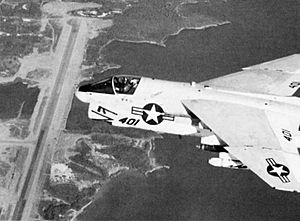
American forces stayed in Grenada after the fighting ended in December. They helped with security and assisted the Caribbean Peacekeeping Force and the Royal Grenadian Police Force. On May 29, 2009, Point Salines International Airport was renamed Maurice Bishop International Airport. This was done on Bishop's 65th birthday. Hundreds of Grenadians came to celebrate this event. Prime Minister Tillman Thomas said the renaming helped bring closure to a difficult time in Grenada's history.
Thanksgiving Day
October 25 is a national holiday in Grenada, called Thanksgiving Day. It remembers the invasion. St. George's University (SGU) built a monument on its True Blue campus. It honors the American service members who died during the invasion. The university holds an annual memorial ceremony on this day.
Military Forces Involved
Vice Admiral Joseph Metcalf, III was the overall commander of the U.S. forces. He led units from the Air Force, Army, Navy, Marine Corps, and Coast Guard. The aircraft carrier USS Independence and the amphibious assault ship USS Guam were key ships.
Ground Forces
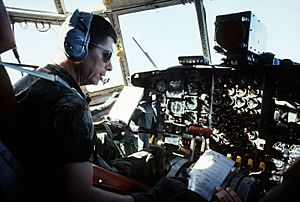
- 75th Ranger Regiment: 1st and 2nd Battalions. They parachuted to secure Point Salines Airport.
- 82nd Airborne Division: Several battalions, including the 325th Infantry Regiment. They landed after the Rangers secured the airport.
- 22nd Marine Amphibious Unit: Marines from Camp Lejeune, NC.
- US Navy SEAL Team 4 and US Navy SEAL Team 6.
- 1st Special Forces Operational Detachment–Delta.
- Various support units like engineers, military police, and medical brigades.
Air Force Units
- 136th Airlift Wing: Provided C-130 Hercules planes for transport.
- Various fighter wings: Provided A-7D Corsair II and A-10 Warthog planes for air support.
- 437th Airlift Wing: Provided C-141 Starlifter planes for airlift.
- 1st Special Operations Wing: Flew AC-130H Spectre gunships.
- 552nd Air Control Wing: Provided air control with E-3 Sentry AWACS aircraft.
Two groups of U.S. warships took part:
- The Independence carrier battle group, including the aircraft carrier USS Independence and several destroyers and frigates.
- The Marine Amphibious Readiness Group, including the flagship USS Guam and other landing ships.
|
See also
 In Spanish: Invasión de Granada para niños
In Spanish: Invasión de Granada para niños


